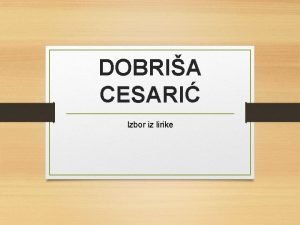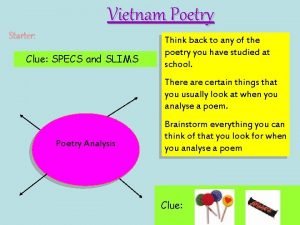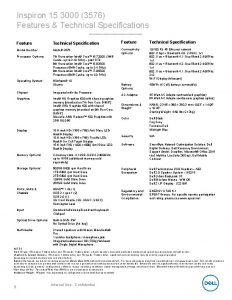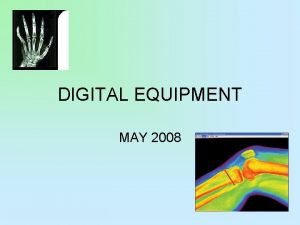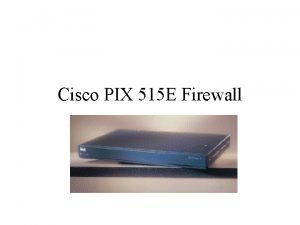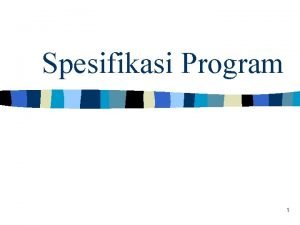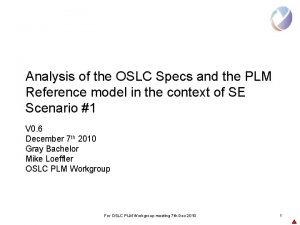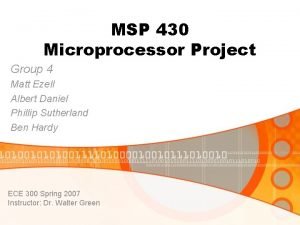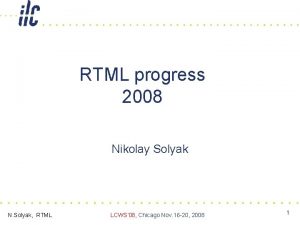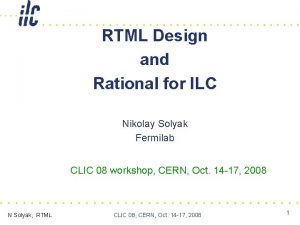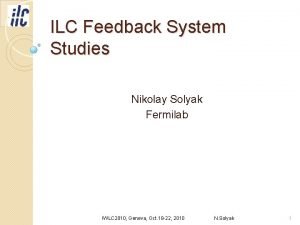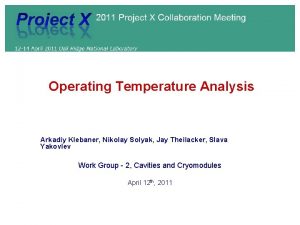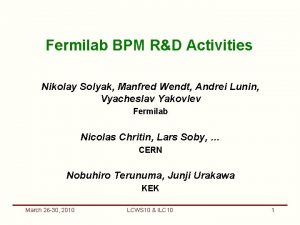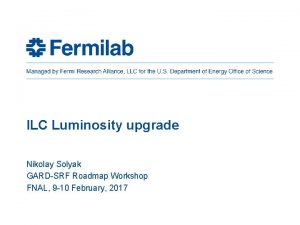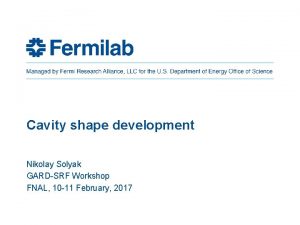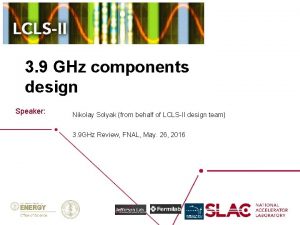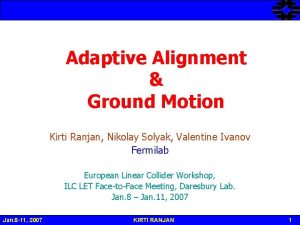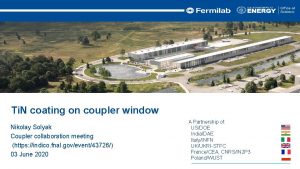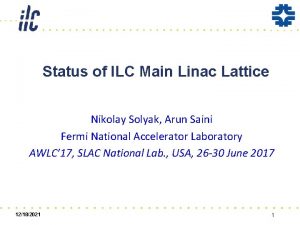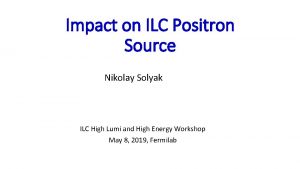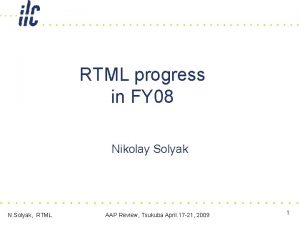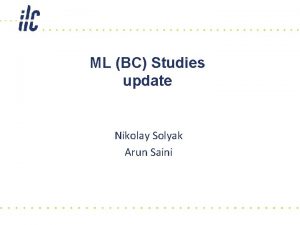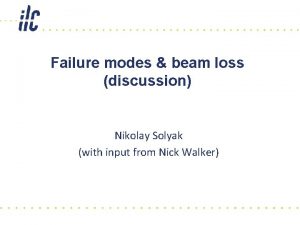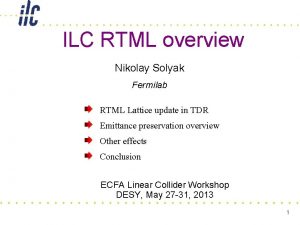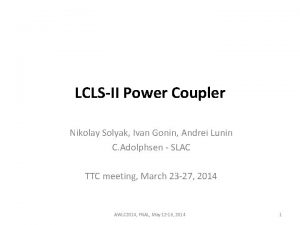ML Quad Requirements and Specs Nikolay Solyak 1262022



















- Slides: 19

ML Quad Requirements and Specs Nikolay Solyak 1/26/2022 Global Design Effort 1

Latest changes in ML CCR#24 a: Change of the cryomodule (CM) layout driven by each of the 10 MW klystron RF unit. Previously’ RF unit consisted of two 8 -cavity C M’s magnet and one 8 -cavity CM with a magnet (8 -8 -8). New RF unit consist of two 9 -cavity CM without a magnet and one 8 -cavity with a magnet (9 -8 -9). Thus, 26 cavities are to be driven by one 10 MW klystron rather than the previous 24. CCR#24 b: Elimination of RF unit overhead. Previously, 3. 5%. Now, 0%. However, the conventional facilities, including the tunnels, are to be maintained to accommodate the missing 3. 5% worth of RF systems if/when determined needed. 1/26/2022 N. Solyak “ML Magnet specs” 2

Main Linac 9 -8 -9 Lattice 37. 956 1/26/2022 Tolerances BPM Offset w. r. t. Cryostat Quad offset w. r. t. Cryostat Quad Rotation w. r. t. Cryostat Structure Offset w. r. t. Cryostat Offset w. r. t. Survey Line Structure Pitch w. r. t. Cryostat Pitch w. r. t. Survey Line BPM Resolution N. Solyak “ML Magnet specs” X/Y plane 300 μm 300 μrad 300 μm 200 μm 300 μrad 20 μrad 1. 0 μm 3

ILC Lattice. Curved linac Dispersion • 1 Quad/3 CM (9 -8 -9) Lattice • Spacing ~38 m • x/y phase advance = 75°/60° • ~10% strength variation in matching sections 1/26/2022 Undulator MAD Beam Trajectory N. Solyak “ML Magnet specs” 4

Energy Upgrade path HE Linac (250 -500 Ge. V) • Half-phase advance, 30 deg • Same layout 1 Q/3 CM • Same Quad strength • Stronger Correctors (~10% if the same curvature) 1/26/2022 N. Solyak “ML Magnet specs” 5

Number of quads Main linac (15 -250 Ge. V) # CM # Quad Electron Linac* 846 282 Positron Linac 834 278 30+30 10+10 Overhead (3. 5%) Total RTML 1680+60** 560+20** 96 36 *Includes 12 CMs to recover 3 Ge. V energy losses in undulator ** Spares (for 3. 5% overhead option) RTML system uses the same CM and quad (LE design) 1/26/2022 N. Solyak “ML Magnet specs” 6

T 4 CM QUAD AND BPM (Without Shield) SUPPORT POST T 4 CM BPM T 4 CM QUAD 1/26/2022 N. Solyak “ML Magnet specs” 7

Quad Strength Integrated Quad strength is defined by quad spacing, required phase advance and beam energy. • Quad spacing s = 38 m (9 -8 -9 cavities in RF unit) • Designed phase advance (mx / my) = 75°/ 60°. For flexibility quad should provide optics with phase advance m = 90° up to E=250 Ge. V. • Quad effective length = 0. 626 m • Add 20% for matching, etc. 1/26/2022 N. Solyak “ML Magnet specs” 8

Magnet strength errors (K. Kubo) (quad and dipole correctors) 1. Vertical position change due to magnet strength error. • Relative magnet strength < 2. 10 -5 0. 14 rms beam offset (Random 0. 14 offset of each beam will make average position offset 0. 2 between two beams at IP, which will decrease luminosity about 3%, without beam-beam force. ) - Can be corrected in train • Very tight but relevant only for fast jitter, faster than orbit feedback 2. Emittance increase due to magnet strength error. • Relative magnet strength < 2*10 -3 / 0 less than 0. 063 (Emittance increase by 0. 063 will decrease luminosity about 3%, without beam-beam force. ) • Stability slower than orbit correction 1/26/2022 N. Solyak “ML Magnet specs” 9

Quad specs • Dimensions: – Beam pipe diameter = 78 mm – Quad total length (z- slot) ~ 0. 66 m (TESLA - 0. 666 m) • Maximum Integrated gradient: (if L=0. 66 m) – (B'*L) = 37 T (B' = 60 T/m) - at 250 Ge. V • Max current: (at 250 Ge. V) = 100 A • Stability: – faster than orbit correction (<1 ms) < 2. e-5 – slower than orbit correction (>0. 2 s) < 1. e-3 • Higher harmonic tolerance: not studied yet – Skew quad < 3. e-4 (at reference radius 5 mm) – High harmonics < 1. e-3 (at r=5 mm) – Field in cavity region <10 m. T (at r=35 mm, z~650 mm from quad center. Cavity has magnetic shielding) 1/26/2022 N. Solyak “ML Magnet specs” 10

Quad specs (cont. ) Alignment tolerances (installation) : • X/Y Position < 0. 3 mm (rms) • Pitch, yaw, roll : < 0. 3 mrad – Reference: TDR alignment (angle) < 0. 1 mrad (~5 um@ 50 mm) • Roll tolerance are tight, needs built-in skew corrector (? ) Field changes: • • 20% of nominal for quad shunting (finding BPM-Quad offset), 100% for ballistic alignment Within a few seconds Center motion: below 2 um for 20% quad strength changes Upgrade Path (500 Ge. V/linac): • twice weaker lattice at high energy (>250 Ge. V) 1/26/2022 N. Solyak “ML Magnet specs” 11

Correctors • Corrector will bend beam in vertical plane to transport beam along earth curvature and correct beam offset y where s - quad spacing, R = 6400 km - Earth radius. • RMS Quad alignment offset: 0. 3 mm; 3 0. 9 mm; • Corrector max field to correct 1. 5 mm beam offset @250 Ge. V • Corrector strength to deflect beam in vertical plane along earth surface is ~10 % of strength needed for beam/quad offset correction. • One corrector for vertical beam deflection in every magnet package and one for horizontal beam deflection in every second package. 1/26/2022 N. Solyak “ML Magnet specs” 12

Correctors specs • Maximum integrated strength (at 250 Ge. V to correct 1. 5 mm beam offset) – 0. 05 [T m] integral strength or 0. 074 T (L=0. 66 m) for 1 Q/3 CM lattice –<10% of strength needs to deflect beam along the Earth curvature Max current: (at 250 Ge. V) = 40 A Stability: same as for quads. • Field change: by a few percent in 0. 2 s, every 0. 2 s • Change step: (~1 mm of quadrupole motion) – 2. e-6 T*m at 15 Ge. V – 3. e-5 T*m at 250 Ge. V 1/26/2022 N. Solyak “ML Magnet specs” 13

Specifications Quad Field quality Dipole coil Beam pipe diameter Inner coil diameter Coil Length Gradient, max Operating T Nominal Current Max Field at conductor N turns/pole Inductance Skew quadrupole Higher harmonics* Alignment error (angle) 78 90 626 60 2 100 3. 6 1007* ~3. 2* 3. e-4 1. e-3 0. 1 mm mm mm T/m K A T Length (if separate) Max Current Max Field at conductor Max Field at axis Inductance < 350 40 3. 6 0. 074 ~29* mm A T T m. H H mrad (rms) ( Some specs are copied from TESLA TDR as a reference) *Tolerances for higher harmonics are probably looser. Need to check. 1/26/2022 N. Solyak “ML Magnet specs” 14

Summary of preliminary magnet studies • Linac SC magnets are feasible. Review - April 5, 2007. • HE magnet design is done. LE magnet in progress. • SC wire for Quad and correctors are available • Prototyping are needed to confirm the specified performance, cost and efficiency • New Cryostat are needed to upgrade existing test stand • Main issues: - Optimal quadrupole configuration - Integrated field range (low: high) - Magnetic center stability during – 20% field change - Combined or stand alone correctors ? - Fringing fields in SCRF areas from magnet package - Effective current leads 1/26/2022 N. Solyak “ML Magnet specs” 15

HOM Absorber Efficiency at High Frequencies (M. Dohlus, absorber_zeuthen_dohlus. pdf) For 300 micron bunch the total losses in CM (8 cav x 9 cells) are about 16 W. Loss spectrum at low frequencies is about the same. 1/26/2022 Global Design Effort 16

Absorbing efficiency estimations at high frequencies: L- length of the absorbing ceramic ring, a – it’s internal radius, λ –wavelength. Efficiency drops with the wavelength! Simple mode of HOM absorber 1/26/2022 N. Solyak “ML Magnet specs” 17

At the frequencies ~30 GHz absorption is about 20% and 10% at 50 GHz. It drops when the frequency increases (not as fast as f-2 because of mode transformation) Ceramics ring diameter should be higher than beam pipe diameter in order to improve efficiency at low frequencies Further HOM absorber investigations are desired in order to improve its properties at HF. 1/26/2022 N. Solyak “ML Magnet specs” 18

Losses caused by the beam in ceramics are small, ~0. 15 W. No high Q trapped modes, no coherent excitation. TM 010 (ceramics) Trapped modes: Mode Frequency, MHz Q Time constant, nsec TM 010 (ceramics) 1. 469 8. 8 1. 9 TM 011 (ceramics) 2. 077 10. 2 1. 6 TM 012 (ceramics) 2. 674 9. 5 1. 1 TM 010 (vacuum) 2. 835 21. 2 2. 4 TM 011 (ceramics) TM 012 (ceramics) TM 010 (vacuum) 1/26/2022 N. Solyak “ML Magnet specs” 19
 Cheg
Cheg Nikolay yakovets
Nikolay yakovets Svyatoy nikolay
Svyatoy nikolay Dobriša cesarić balada iz predgrađa analiza
Dobriša cesarić balada iz predgrađa analiza Specs slims
Specs slims Popsmars
Popsmars Specs 290 and jones
Specs 290 and jones Ibm emperor ii
Ibm emperor ii Nimble af40 iops
Nimble af40 iops Netapp ds460
Netapp ds460 Nexus 5020 layer 3
Nexus 5020 layer 3 Packaging quality assurance
Packaging quality assurance Inspiron 15 3573 specs
Inspiron 15 3573 specs Arrt content specs
Arrt content specs Cisco pix firewall price
Cisco pix firewall price Contoh spesifikasi program
Contoh spesifikasi program 6320 hp
6320 hp Specs
Specs Msp430 specs
Msp430 specs Toshiba 3055c specs
Toshiba 3055c specs



